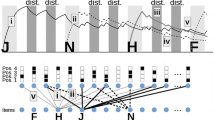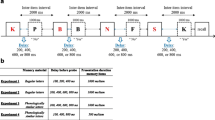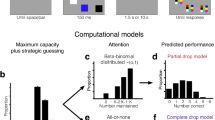Abstract
Short-term memorization of items while performing a concurrent distracting task requires maintenance processes. The time-based resource-sharing model of working memory (Barrouillet et al. in Psychol Rev 118:175–192, 2011) and its computational version TBRS* (Oberauer and Lewandowsky in Psychon Bull Rev 18:10–45, 2011) proposed that items are refreshed when attention is not captured by the distracting activity. However, these models are unable to account for human performance on the last items when temporal constraints are substantial. The present study presents an analytic approach and computational simulations showing that the sequentiality of the domain-general attentional refreshing mechanism is responsible for the discrepancy between humans and model. It is suggested that the focus of attention could be flexible. The implementation of a computational model based on this solution provides a much better fit to human data. Outcomes are discussed in reference to contemporary works on the phonological loop as well as in reference to other computational models of short-term memory.








Similar content being viewed by others
Notes
Because the number of squares condition (4 and 8 squares) did not have any effect on recall performances, the three SPC represent data for the three pace conditions (slow, medium, fast) irrespective of the number of squares.
For sake of clarity, it is worth noting that in the present case, B would have been refreshed once plus once more during a fraction of time of about 70 ms (corresponding to the remaining time available after having refreshed the ABCA sequence).
Refreshing in TBRS* is based on Hebbian association learning. With this mechanism, it is not possible to associate n items with n positions simultaneously so that the first item is associated with the first position, the second item to the second position, and so on. So, even if the refreshing is conceptually simultaneous across multiple item-position associations, at a computational level, refreshing still occurs sequentially, one item-position association at a time, but in such a way that four subsequent item-position associations are grouped together, and assigned a single duration Tr.
Other simulations showed that an improvement over the original model has already appeared with an attentional focus size of two and is increasing slightly with a size of three, then four.
References
Anderson JR, Bothell D, Lebiere C, Matessa M. An integrated theory of list memory. J Mem Lang. 1998;38:341–80.
Baddeley AD. Working memory. Oxford: Clarendon Press; 1986.
Baddeley AD, Eysenck M, Anderson MC. Memory. Hove: Psychology Press; 2009.
Barrouillet P, Bernardin S, Portrat S, Vergauwe E, Camos V. Time and cognitive load in working memory. J Exp Psychol Learn Mem Cogn. 2007;33:570–85.
Barrouillet P, Portrat S, Camos V. On the law relating processing to storage in working memory. Psychol Rev. 2011;118:175–92.
Brown GDA, Neath I, Chater N. A temporal ratio model of memory. Psychol Rev. 2007;114:539–76.
Brown GDA, Preece T, Hulme C. Oscillator-based memory for serial order. Psychol Rev. 2000;107(1):127–81.
Burgess N, Hitch GJ. Towards a network model of the articulatory loop. J Mem Lang. 1992;31:429–60.
Camos V, Lagner P, Barrouillet P. Two maintenance mechanisms of verbal information in working memory. J Mem Lang. 2009;61:457–69.
Camos V, Mora G, Barrouillet P. Phonological similarity effect in complex span task. Q J Exp Psychol. 2013;66:1927–50.
Camos V, Mora G, Oberauer K. Adaptive choice between articulatory rehearsal and attentional refreshing in verbal working memory. Mem Cogn. 2011;39:231–44.
Chen Z. Attentional focus, processing load, and stroop interference. Percept Psychophys. 2003;65:888–900.
Cowan N. An embedded-process model of working memory. In: Miyake A, Shah P, editors. Models of working memory: mechanisms of active maintenance and executive control. Cambridge: Cambridge University Press; 1999. p. 62–101.
Cowan N. Working memory capacity. Hove: Psychology Press; 2005.
Cowan N, Elliott EM, Saults JS, Morey CC, Mattox S, Hismjatullina A, Conway ARA. On the capacity of attention: its estimation and its role in working memory and cognitive aptitudes. Cogn Psychol. 2005;51:42–100.
Cowan N, Morey CC, Chen Z, Bunting M. What does estimates of working memory capacity tell us? In: Osaka N, Logie R, D’Esposito M, editors. The cognitive neuroscience of working memory. Oxford: Oxford University Press; 2007. p. 43–58.
Cowan N, Saults JS, Elliott EM. The search for what is fundamental in the development of working memory. Adv Child Dev Behav. 2002;29:1–49.
Davis LC, Rane S, Hiscock M. Serial recall of visuospatial and verbal information with and without material-specific interference: implications for contemporary models of working memory. Memory. 2013;21:778–97.
Engle RW, Kane MJ, Tuholski SW. Individual differences in working memory capacity and what they tell us about controlled attention, general fluid intelligence, and functions of the prefrontal cortex. In: Miyake A, Shah P, editors. Models of working memory: mechanisms of active maintenance and executive control. Cambridge: Cambridge University Press; 1999. p. 102–34.
Farrell S, Lewandowsky S. An endogenous model of ordering in serial recall. Psychon Bull Rev. 2002;9:59–79.
Gaillard V, Barrouillet P, Jarrold C, Camos V. Developmental differences in working memory: Where do they come from? J Exp Child Psychol. 2011;110:469–79.
Henson RNA, Norris DG, Page MPA, Baddeley AD. Unchained memory: error patterns rule out chaining models of immediate serial recall. Q J Exp Psychol. 1996;49A:80–115.
Kanerva P. Sparse distributed memory. Cambridge: The MIT Press; 1988.
Lewandowsky S, Farrell S. Computational models of working memory. In: Nadel L, Chalmers D, Culicover P, Goldstone R, French B, editors. Encyclopedia of cognitive science. London: Macmillan; 2002. p. 578–83.
Lewandowsky S, Farrell S. Computational modeling in cognition: principles and practice. Thousand Oaks, CA: Sage publication; 2010.
Lewandowsky S, Murdock BB. Memory for serial order. Psychol Rev. 1989;96:25–57.
Lewandowsky S, Oberauer K, Yang LX, Ecker UKH. A working memory test battery for MATLAB. Behav Res Methods. 2010;42:571–85.
Mora G, Camos V. Two Systems of Maintenance in Verbal Working Memory: evidence from the Word Length Effect. PLoS ONE. 2013;8:8.
Murdock BB Jr. Effect of a subsidiary task on short-term memory. Br J Psychol. 1962;56:413–9.
Oberauer K, Lewandowsky S. Modeling working memory: a computational implementation of the time-based resource-sharing theory. Psychon Bull Rev. 2011;18:10–45.
Oberauer K, Lewandowsky S, Farrell S, Jarrold C, Greaves M. Modeling working memory: an interference model of complex span. Psychon Bull Rev. 2012;19:779–819.
Page MPA, Norris D. The primacy model: a new model of immediate serial recall. Psychol Rev. 1998;105:761–81.
Pashler H. The psychology of attention. Cambridge, MA: MIT Press; 1998.
Portrat S, Barrouillet P, Camos V. Time-related decay or interference: based forgetting in working memory? J Exp Psychol Learn Mem Cogn. 2008;34(6):1561–4.
Snaider J, Franklin S. Extended sparse distributed memory and sequence storage. Cogn Comput. 2012;4:172–80.
Tan L, Ward G. Rehearsal in immediate serial recall. Psychon Bull Rev. 2008;15:535–42.
Townsend JT, Wenger MJ. The serial–parallel dilemma: a case study in a linkage of theory and method. Psychon Bull Rev. 2004;11:391–418.
Vergauwe E, Barrouillet P, Camos V. Do mental processes share a domain-general resource? Psychol Sci. 2010;21:384–90.
Vergauwe E, Camos V, Barrouillet P. The effect of storage on processing: How is information maintained in working memory? J Exp Psychol Learn Mem Cogn. 2014;40(4):1072–95.
Acknowledgments
We thank anonymous reviewers of a previous version of this paper whose comments helped us to improve the manuscript, as well as the “Région Rhône-Alpes” for its financial support.
Author information
Authors and Affiliations
Corresponding author
Rights and permissions
About this article
Cite this article
Portrat, S., Lemaire, B. Is Attentional Refreshing in Working Memory Sequential? A Computational Modeling Approach. Cogn Comput 7, 333–345 (2015). https://doi.org/10.1007/s12559-014-9294-8
Received:
Accepted:
Published:
Issue Date:
DOI: https://doi.org/10.1007/s12559-014-9294-8




